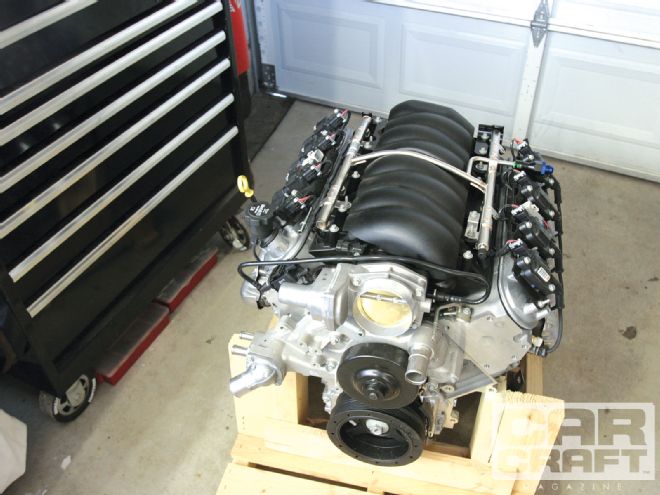
The Camaro LS3 crate engine makes the LS series of engines legit. Up until now, you had to either spend ahoy on the gigabuck LS7, be happy with the iron 6.0L and its weird truck accessory drive, or strip down a pricey LS2 Corvette to get the coveted factory 4.00-inch-plus small-block bore size. For about $6,500, the new Camaro LS3 crate engine packs a 4.065-inch bore and matching performance cylinder heads and makes 430 hp and 424 lb-ft from the factory. This thing is such a good deal, you have to pay attention.
The power potential of the LS3 crate engine comes from its ability to use the L92 cylinder head port design. We've tested this head before on a stock 6.0L and made 550 hp with a cam swap, so we know it works. We wanted to use this head on other LS-series engines like the LS1 (5.7L) or LM4 (5.3L), but the 2.165/1.59-inch valves require at least a 4.00-inch bore to clear the block and need the 4.065-inch LS3 bore size to be really happy. In addition to the base LS3, there are two variations of the LS3 crate engine also available. The LS3-based LS376 has a Hot cam and is rated at 480 hp. Add a single-plane GM intake and the ASA Hot cam, and GM claims the LS376 will make 515 hp and 469 lb-ft with a GM competition single-plane carbureted intake and a 770-cfm Holley. Remember, this engine is only 376 ci.
If you go for the base LS3, you get a cast-aluminum block with iron cylinder liners, six-bolt cross-bolted main caps, and the L92 heads. The cylinder liners are designed for the stock 3.600-inch stroke, but it is possible to go to 4.00 inches. With the maximum overbore of 0.030, the block has the potential for 421 inches using an aftermarket rotator assembly. The cam is a hydraulic roller with 204/211 degrees of duration at 0.050 with 0.551/0.522 lift. The heads have a 68cc chamber and with the hypereutectic aluminum pistons yield a 10.7:1 compression ratio, so the engine needs 92- octane pump gas. The intake and drive-by-wire throttle body are included, but you'll need to buy the GM pedal assembly. GM offers an LS3 controller to run the system in everything from a street machine to a street rod.
Head Flow We've tested the L92 port before on a different flow bench and our published numbers are slightly higher than the ones provided by GM below. The GM tests were performed with a 4.065-inch bore plate.
Head Flow
We've tested the L92 port before on a different flow bench and our published numbers are slightly higher than the ones provided by GM below. The GM tests were performed with a 4.065-inch bore plate.
A Brief History of the Production LS Family
It all started with the LS1 in the then-stupendous '97 Corvette. The engine was like nothing we'd seen before with all the go-fast theories applied from the factory. The problem, if you could call it that, was the less-than-big 3.90-inch bore that required slightly smaller valves (2.00/1.55) than we were used to. It is a great engine, but at the time, you had to part-out a '98 Camaro or said Corvette to get your hands on a used one. In 1999, the 4.8L and 5.3L LS engines were used in GM trucks and vans, opening the door for LS-hungry parts swappers like yourself to add LS power to the old Chevelle. Since we all wanted more power, guys were sleeving and boring these engines toward the magical 4.00 mark, often with disastrous results.
In 2001, the iron LQ4/LQ9 6.0L quietly appeared in big SUVs with a 4.00-inch bore, but few seemed to recognize the potential. It wasn't until the LS2 appeared in the '05 Corvette that the combination of a 4.00-inch bore and LS1/LS6 heads was mixed for a factory 400 hp. It was a really big deal at the time. To feed fatter trucks and larger displacements, GM designed another head dubbed the L92. It used the rectangular ports you see here. By 2008, big trucks like the Escalade and Yukon Denali and Corvettes were all using an even larger version of the LS called the L92/LS3. It has a 4.065-inch bore and the L92 port designs, giving it great factory numbers like 436 hp and 428 lb-ft in the '08 Corvette. There are also supercharged versions of this engine in the Cadillac CTS-V and 638hp ZR1 Corvette.
Since you can't have a truck out-gunning a Vette, the 7.0L LS7 appeared in 2008 with a 4.125 bore and went way over the top in the N/A 505hp Z06 Corvette. The LS7 is currently state of the art with a 4.125-inch bore and special LS7 12-degree heads that flow more than 350 cfm at 0.700 valve lift. We haven't seen a supercharged version of the LS7 yet but can imagine its potential. Is an 800hp Corvette in the future?
Would you like meatballs with that?
Once again, do not hook this up to your barbecue.